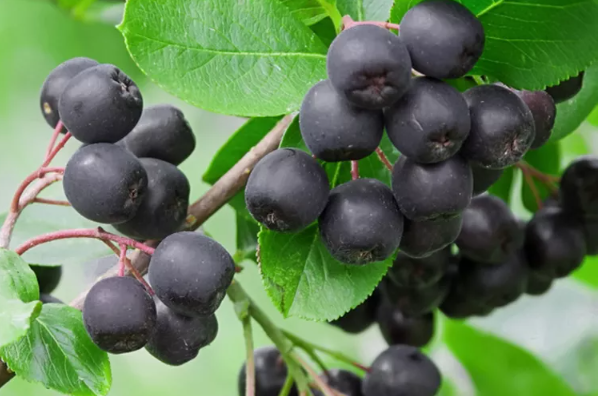
The Chokeberry Plant (Aronia) is a deciduous shrub native to eastern North America from Canada down to the central United States. It is commonly found in wet woods and swamps, and is recognized for its clusters of white flowers and dark, glossy leaves that turn red in the fall. The plant produces small, edible berries that ripen to a deep purple or black color. The name “chokeberry” comes from the astringency of the fruits, which create the sensation of making one’s mouth pucker.
The cultivation and commercial use of Aronia berries began around the early 1900s in Eastern Europe, where the plant was recognized for its high nutritional value and potential health benefits. The berries were then introduced to other parts of Europe and the world, where they have been grown and used to make wine, jam, syrup, juice, soft spreads, tea, salsa, extracts, beer, ice cream, gummies, and tinctures.
There are three main species of Aronia:
- Black chokeberry (Aronia melanocarpa): This is the most common type, native to eastern North America. It produces black or purplish-black berries.
- Red chokeberry (Aronia arbutifolia): This type is also native to eastern North America and has red berries.
- Purple chokeberry (Aronia prunifolia): This is a hybrid of the black and red chokeberry, with fruits that are a deep reddish-purple color.
Red chokeberry (Aronia arbutifolia) and black chokeberry (Aronia melanocarpa) are spring-flowering shrubs that have red fall foliage and winter berries. The shrubs grow up to 10 feet tall and 6 feet wide. Red chokeberries grow in U.S. Department of Agriculture plant hardiness zones 4 through 9, and black berries in zones 3 through 8. The shrubs grow in full sun or partial shade and prefer slightly acidic, sandy soil, though they are tolerant of many soil conditions. In rich soil they need minimal fertilization.
Chokeberries are often confused with chokecherries, which are actually Prunus virginiana. Both chokecherries and Aronia berries contain polyphenolic compounds like anthocyanins, although they are only distantly related within the Rosaceae family. Black chokeberry is commonly cultivated as a shrub in Central Europe, primarily for food production.
Characteristics of Chokeberry Plant
- Size: The plants grow to a height of 3-8 feet, with a spread of 3-6 feet.
- Growth Habit: They have a multi-stemmed, deciduous growth habit.
- Growth Rate: Chokeberry plants have a slow to moderate growth rate.
- Bark: The bark is reddish-brown, thin, smooth, and exfoliating.
- Flowers: In spring, clusters of showy 5-petaled white flowers bloom.
- Leaves: The leaves are glossy dark green above and pubescent grayish-green beneath, turning brilliant red in the fall.
- Berries: The fruits are glossy red to purple-black, 1/4 to 1/3 inch in diameter, and appear in dense clusters along the branches.
- USDA Zone: The plants thrive in USDA hardiness zones 3 to 8.
- Lifespan: With proper care, chokeberry plants can live for many years.
- Bloom Time: They plants bloom in spring.
- Root System: Chokeberry plants have a fibrous root system.
Cultivation of Chokeberry Plant(Aronia)
Growing Conditions
- Soil: Chokeberries are adaptable to various soil types, including clay, loamy, and sandy soils. They prefer well-drained soil but can tolerate wet conditions.
- Sunlight: They thrive in full sun to partial shade. Full sun promotes better flowering and fruit production.
- Watering: These plants are relatively drought-tolerant once established but benefit from regular watering, especially during prolonged dry spells.
Planting and Care
- Planting: Plant chokeberries in early spring or fall. Space them 4 to 6 feet apart to allow for mature growth.
- Pruning: Prune in late winter or early spring to remove dead or diseased branches and to shape the plant.
- Mulching: Apply a 2-3 inch layer of mulch around the base to retain moisture, suppress weeds, and regulate soil temperature.
- Fertilizing: Fertilize in early spring with a balanced fertilizer to support healthy growth and fruit production.
How to Prune Chokeberry
- Timing: Prune chokeberry in late winter or early spring, before new growth begins.
- Tools: Use sharp, clean pruning shears or loppers to make clean cuts.
- Dead or Damaged Branches: Start by removing any dead, diseased, or damaged branches. Cut these back to healthy wood.
- Shaping: Chokeberry can be pruned to maintain a desired shape or size. Cut back any branches that are crossing or rubbing against each other.
- Thin Out: Thin out the shrub by removing some of the oldest branches at ground level. This will encourage new growth.
- Tips: When pruning, make cuts just above a bud or a branch junction. Avoid leaving stubs, as these can lead to disease.